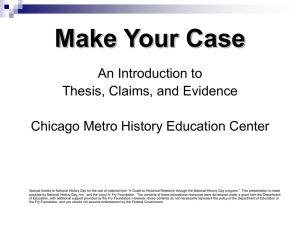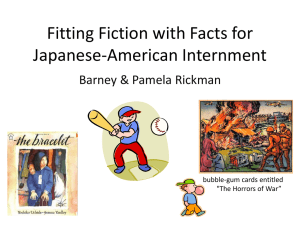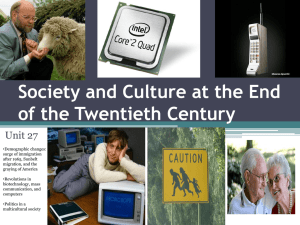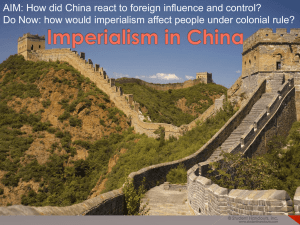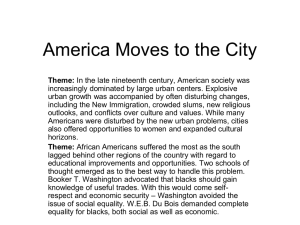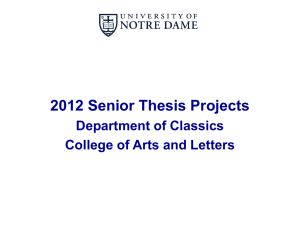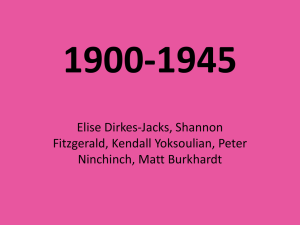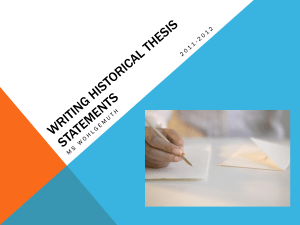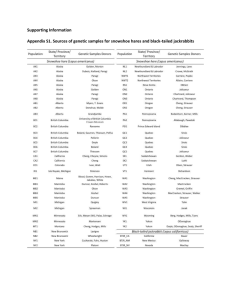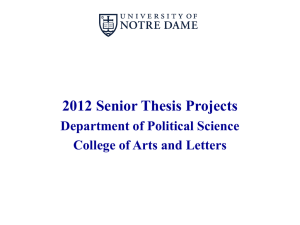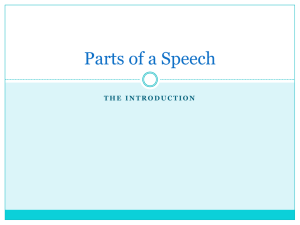Chinese, Japanese, and Filipino Americans
advertisement
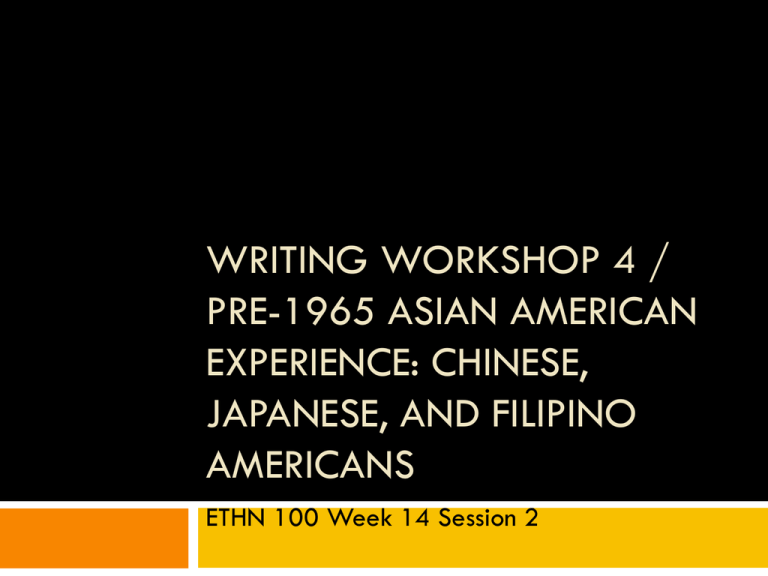
WRITING WORKSHOP 4 / PRE-1965 ASIAN AMERICAN EXPERIENCE: CHINESE, JAPANESE, AND FILIPINO AMERICANS ETHN 100 Week 14 Session 2 Last Time Discussed Amy Tan’s “Mother Tongue” in relation to key concepts from ETHN 100 Examined circumstances of early Chinese and Japanese immigration to the United States. Today Reflect on individual and collective performance on WA3. Prepare for WA4 Examine Japanese and Filipino American immigration to the United States. Grading Scale A = 22.5 – 25 B = 20 – 22.49 C = 17.5 – 19.99 D = 15 – 17.49 F = 0 – 14.99 WA2 and WA3 Score Distribution (Section 03) WA2 A=6 B = 12 C=9 D=1 F=1 WA3 A= 8 B = 15 C=7 D=0 F=0 WA2 vs. WA3: General Observations Much improved! Most students earned “improvement points” towards WA2 scores. Stronger thesis statements led to more focused arguments. On the whole, more analysis and less summarizing. The logic/connections among ideas remains relatively weak. This last point is the focus of today’s workshop. Ideas: Observations from WA3 Much better titles. Thesis statements were more focused. Be careful that your thesis doesn’t simply state the obvious. As much as possible, you want to try to say something interesting; your goal is to try to show sophistication of thought and contribute original thinking. Ideas: Suggestions for WA4/Final The prompt for WA4 requires you to use more general language in your thesis since you aren’t speaking about specific ethnic groups. Exemplary Thesis Statements from Past Semesters Sample Thesis Statement 1 “Dominant cultural status is established and reinforced by both structural and cultural means. Institutions maintain systems of power and privilege by promoting one group’s worldview, rituals, and values to appear neutral, natural, and objective.” Sample Thesis Statement 2 “Inequality is produced and maintained by ideologies that represent the racial or ethnic “other” as culturally uncivilized and socially deviant. Collective identities of non‐dominant groups often evolve in response to these representations and to the unfair treatment these stereotypes serve to justify.” Sample Thesis Statement 3 “The growth of industrialization—characterized by mechanized and mass production of goods for global markets—requires natural resources, cheap labor, and complex belief systems that favor property rights over human rights.” Organization and Coherence: Observations from WA3 Most papers present “middle ideas” that are unlinked to one another. Still a lot of “and then” or “another example” papers. Organization and Coherence: Suggestions for WA4/Final Focus on the relationship between the “middle ideas” Idea Maps Transitions between ideas. Strong topic sentences. Sample “Idea Maps” Sample Thesis Statement 1 “Dominant cultural status is established and reinforced by both structural and cultural means. Institutions maintain systems of power and privilege by promoting one group’s worldview, rituals, and values to appear neutral, natural, and objective.” Sample Idea Map “Support for this thesis is organized into four parts. First, a brief discussion of the relationship between social structure and culture reveals the centrality of institutional power in distributing status and privilege among groups in a society. Second, examples of historical moments from the African American and Native American experiences illustrate this relationship between social structure, culture, and power. Third, an analysis of contemporary issues among Chicanos and Asian and Pacific Islander Americans exemplifies the perpetuation of racial and ethnic inequality today. And fourth, a brief exploration of the relevance and implications of this thesis to ethnic struggle and conflict in global terms.” Support: Observations from WA3 More analysis than summary than WA2 but still room for improvement. Linkages between evidence are often unarticulated. (Laundry list of evidence). Support: Observations from WA3 Elaborate on your analysis of your evidence. Circle back to your thesis! How does your evidence support your argument? This helps to connect your ideas to one another. Sample List of Evidence from the Course Sample Thesis Statement 3 The growth of industrialization—characterized by mechanized and mass production of goods for global markets—requires natural resources, cheap labor, and complex belief systems that favor property rights over human rights. Evidence Cited Comparison of social structures and Rise of Industrialization: Southern Agrarian Economy (plantations) vs. Northern Industrial Economy (urbanization and ghettos) Need for resources: Native American and Mexican Land Ideology: Paternalism and Manifest Destiny Need for cheap labor: African Americans, Chicanos, Asian Americans Ideology: Happy slaves; uncivilized and savage racial others. Chinese Exclusion Act of 1882 Barred immigration of Chinese laborers for 20 years (two, ten-year periods) Outwitted immigration laws (resistance): undocumented and documented entry Undocumented: Entered the country (CA) via Northwestern and southern points of entry. Extralegal: Misrepresented their status to enter with papers. Japanese Immigration Modernization, industrialization, and militarization Immigration mainly to Hawaii (sugar) and California (fruit and produce). Chinese immigrants vs. Japanese immigrants From the Chinese Exclusion Act of 1882 to the Gentlemen’s Agreement of 1907 Picture Brides Hawaii Sugar Plantations Describe labor conditions among the immigrant ethnic groups on the Hawaiian sugar plantations were often stratified. Groups were pitted one against the other. Japanese laborers attempted “blood unionism” Filipino and Japanese workers strike (1909) Filipino Immigration Filipinos were uniquely situated in immigration history because they were colonial subjects of the United States due to the Spanish American War (1898) and Philippine-American War (1899-1902) President McKinley: “Little Brown Brothers.” Three waves: Pensionados Manongs Post-1965 Professionals and Families First Wave: Pensionados or “Fountain Pen Boys” (early 1900s) Filipino young men from elite families were brought to the United States to be educated in US colleges and universities. These students returned to the Philippines. These students were an integral strategy to US colonization of the Philippines. The goal was to import US culture, education, and institutions via families of status. Second Wave: Manongs (1900-1965) Filipino laborers were brought to the United States when Chinese, Japanese, and Mexican laborers were in short supply due to exclusion and discrimination. Hawaii, Pacific Coast (California), Alaska Almost entirely men. Worked mainly in agriculture, food production (canneries, packing houses), and as domestic help (“house boys”). Anti-miscegenation Laws The Great Depression Watsonville Riot Third Wave: Post-1965 Professionals and Family Reunification Immigration Act of 1965 created a new system of preferences for immigrants to the United States. Favored forms of labor and family ties. Despite the assumption that it would mainly benefit European groups, Asian Americans were among the most affected.

